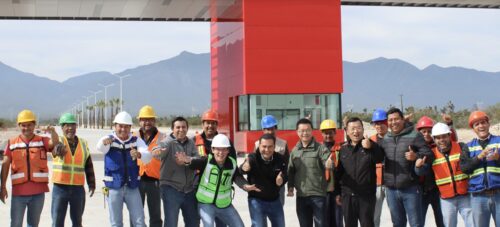NIO’s plans to become China’s Tesla
NIO is launching two new electric sedans this year as well as an SUV, and expects record high sales in June.

On June 10, Tesla’s new Model Y SUV, starting at $54,440, was launched in Australia, with demand so high that Tesla had to postpone delivery dates. Five days later, Chinese electric vehicle (EV) manufacturer NIO 蔚来汽车 held an online launch for its new high-end model, the electric SUV ES7, priced at 468,000-548,000 yuan ($69,766-81,692).
In China, the ES7 arrives at an opportune time: Following the introduction of new regulations on April 1, Chinese drivers can now apply for a C6 driver’s license for light recreational vehicles (RVs) and trailers. During the launch, CEO Lǐ Bīn 李斌 presented the ES7 as a direct competitor of the BMW X5, and the perfect vehicle for the camping craze that is sweeping China. It is the first passenger car in China that can legally tow RVs and trailers.
- The vehicle can be equipped with an electric tow hook with a capacity of two tons, and supports power supply for towed equipment.
- It is equipped with an ultra-long battery of 150kWh, with a battery life of over 850 kilometers (528 miles).
The ES7 is one of three new models NIO is launching this year: A sedan model, the ET7, was launched in March; and another sedan, the ET5, will be launched in September. The latter two will compete at a lower price range (200,000-300,00 yuan) than the ES7. This is the first time that a Chinese auto manufacturer launched three new models in one year.
The context
NIO is a member of the Wèixiǎolǐ 蔚小理 triumvirate of up-and-coming Chinese EV manufacturers, with the others being Li Auto 理想汽车, and XPeng Motors 小鹏汽车. On May 9, NIO released its first quarter numbers, the last of the triumvirate to do so, and there were mixed results for the three companies:
- NIO reported the highest revenues: 9.91 billion yuan ($1.47 billion), a year-on-year increase of 24.2% and a month-on-month increase of 0.9%. Of the three, only NIO’s revenues increased from the previous month. Li Auto and XPeng reported revenues of 9.56 billion yuan ($1.42 billion), a year-on-year increase of 167.5%; and 7.45 billion yuan ($1.10 billion), a year-on-year increase of 152.6%, respectively.
- XPeng achieved the highest sales numbers, about 35,000 units, while Li Auto sold 31,700 units and NIO sold 25,800 units. NIO claimed it was most affected of the three companies by supply chain and production issues in the first quarter, and expects to reach a record high number of deliveries in June.
- NIO made the highest investments in research and development, 1.76 billion yuan ($262.37 million, 17.76% of total revenues), while XPeng spent 1.22 billion yuan ($182.01, 16% of total revenues), and Li Auto spent 1.37 billion yuan ($204.82 million, 14.3% of total revenues).
- NIO’s gross profit margin, however, is declining, from 17% a year ago to 14.6% in the first quarter, while the gross profit margins of both Li Auto and XPeng increased over this period.
In May, 360,000 electric passenger vehicles were sold in China, a year-on-year increase of 91.2% and a month-on-month increase of 27.3%. However, the penetration rate of high-end electric vehicles priced at 400,000 yuan ($59,629) and above is still only 12%. While XPeng’s average sale price exceeded 250,000 yuan ($37,268) last year, NIO’s average sales price is in the range of 450,000 yuan ($67,083), on par with BMW and Mercedes-Benz, and out of reach for mainstream consumers.
But with the company’s two new sedan models launching this year, which will be produced at its new whole vehicle and core components factory covering over 300 acres in Hefei, Anhui Province (set to be completed in 2024), NIO is focusing on both the mid and high-end segments of the electric vehicle market.
The takeaway
With three new models this year, NIO is intent on advancing on all fronts and to become a globally recognized competitor of Tesla.






